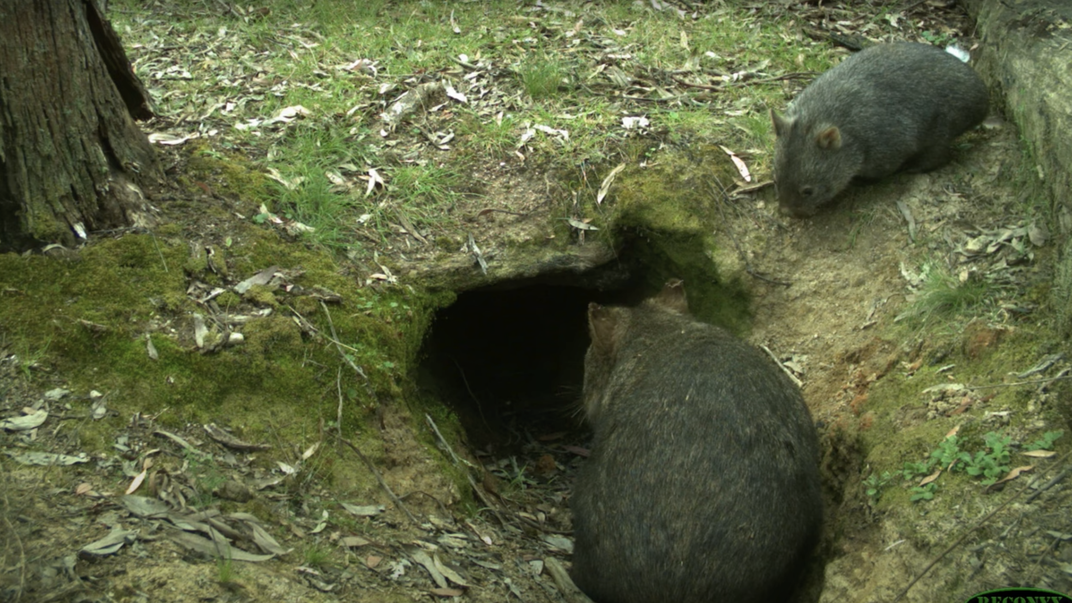Don’t Call Wombats Heroes, but Their Burrows Do Provide Food, Water and Shelter for Other Animals
During Australia’s devastating bushfires in 2019 and 2020, misinformation spread about wombats welcoming animals into their underground homes—but a new study finds a kernel of truth in the viral story
:focal(1000x705:1001x706)/https://tf-cmsv2-smithsonianmag-media.s3.amazonaws.com/filer_public/f8/fd/f8fd73a1-d543-4846-9f41-955996eee6bf/gyae034_fig1.jpeg)
During Australia’s Black Summer bushfires in 2019 and 2020, a fantastical tale began to make the rounds on social media: Wombats were apparently shepherding other animals into their underground burrows to help them survive the blaze.
The viral story seemed too good to be true—and it was. Experts quickly debunked the myth of the heroic and selfless wombat.
But, as it turns out, wombat burrows may be more important than scientists previously thought. Though the muscular marsupials don’t personally welcome wildlife into their homes, their subterranean chambers do serve as important sources of shelter, food and water for other creatures, according to a paper published in May in the Journal of Mammalogy.
For the study, researchers focused on the extensive underground burrow systems created by bare-nosed, or common, wombats (Vombatus ursinus) in the forests of southeastern Australia, an area that had been badly burned by the Black Summer fires.
Bare-nosed wombats have short legs, coarse hair, rounded ears and pouches for holding their young. Though small in stature, these hefty creatures can grow upwards of three feet long and weigh up to 85 pounds—like a medium-sized dog. They also poop cubes, a mystery that, until recently, had long baffled scientists. Wombats use their claws and teeth to dig complex burrow networks that help them stay cool during hot Australian summers.
The researchers set up 56 trail cameras near Albury, New South Wales, with half pointed at wombat burrows and half pointed at areas with similar vegetation but no burrows. They distributed the cameras among sites with varying degrees of fire damage.
Running day and night from June 2021 to April 2022, the cameras captured 746,674 total images, including 370,845 photos with animals in them. After sifting through the images, the team identified 56 species at wombat burrow sites, including 19 types of mammals, 33 birds and four reptiles.
Of the 56 animals, 47 were native species—including bush rats, agile antechinuses, lace monitors and painted button-quail—and nine species were introduced.
Overall, the cameras captured more native mammal species at the burrows than at the sites without burrows. Smaller mammals were more common than larger ones, including kangaroos and wallabies, which seemed to avoid the burrows—perhaps because wombats are territorial.
Some of the animals were seen simply inspecting the burrows, while others were spotted entering and leaving burrows. After rainfall flooded the underground systems, some animals used them as watering holes for drinking and bathing. And nearly a dozen species were seen eating inside or around the lips of the burrows.
“Wombats alter the soil, topography and vegetation around their burrows,” says study co-author Grant Linley, an ecologist at Charles Sturt University in Australia, in a statement. “They turn over tonnes of soil constructing a burrow, and their scats increase nitrogen levels, which boosts herb cover. We think these changes increase the foraging opportunities for small insectivores and omnivores.”
The presence of small animals, in turn, may attract larger predators—so the burrows could have ripple effects up and down the food chain, Linley adds.
/https://tf-cmsv2-smithsonianmag-media.s3.amazonaws.com/filer_public/04/2c/042c80c0-a97b-4be4-8a96-7c72af5934d6/gyae034_fig3.jpeg)
Given the wide variety of ways animals interacted with the burrows, Linley says the structures can serve as “an Airbnb or a supermarket” to the Guardian’s Graham Readfearn.
The findings support the idea of protecting wombats, which have “declined markedly” since European colonization, as Linley and co-author Dale Nimmo, also an ecologist at Charles Sturt University, write in the Conversation.
And, as wildfires worsen amid human-caused climate change, these stocky critters may offer some valuable insights for how creatures can adapt to the changes.
With their spacious, cool, long-lasting burrows, wombats are providing “value for the broader community,” says Meg Krawchuk, a fire ecologist at Oregon State University who was not involved in the research, to the New York Times’ Darren Incorvaia.
“I don’t see that in any of our Fire Ecology 101, and that’s really neat,” she adds.
/https://tf-cmsv2-smithsonianmag-media.s3.amazonaws.com/accounts/headshot/SarahKuta.png)


/https://tf-cmsv2-smithsonianmag-media.s3.amazonaws.com/accounts/headshot/SarahKuta.png)